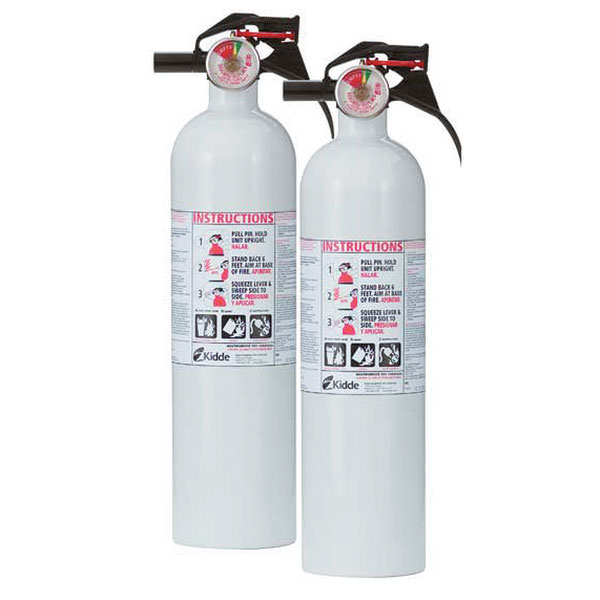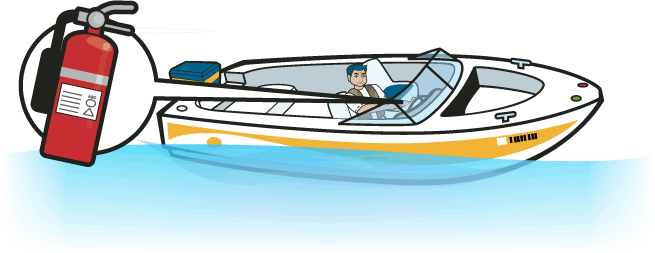
Which types fire extinguisher is used in lifeboat as per SOLAS. C Size I counts as a required Type B-I extinguisher.

Fires are classified as follows.
Type b fire extinguisher boat. All vessels including PWC are required to have a Type B USCGapproved fire extinguisher on board if one or more of the following conditions exist. Closed compartments under seats where portable fuel tanks may be stored. Closed storage compartments in which flammable or combustible materials may be stored.
A gasoline fire is a Type B. This is not the kind of fire you want to try to extinguish with water. Throwing water on a fire that is caused by burning gas or oil will make the liquid spread.
A small fire could become out of control with the addition of water. The proper fire extinguisher for this may be foam or dry chemical. Carbon dioxide is also used.
Make sure Type B is indicated on the label. However extinguisher markings can be confusing. For example one extinguisher can be approved for several different types of fires A B or C.
In that case its important to know that an extinguisher marked Type A Size II. C Size I counts as a required Type B-I extinguisher. On Type A extinguishers the number relates to how many gallons of water the extinguisher is equal to for a Type A fire.
Type B fires are of flammable liquids such as gasoline or oil. On Type B extinguishers the number tells you the square footage of the fire the extinguisher can put out. What fire extinguisher is on boats.
Class B fire extinguishers Use a Class C fire extinguisher. Because gasoline fires are the most common type of boat fire marine-rated Class B fire extinguishers are the class required on most boats. The number after the B for example a B1 or B2 extinguisher indicates the capacity of the extinguisher.
Under what conditions is a Type B-1 fire extinguisher required. All vessels including PWC are required to have a Type B USCGapproved fire extinguisher on board if one or more of the following conditions exist. Closed compartments under seats where portable fuel tanks may be stored.
Up to 26. One B-I size extinguisher. Fire extinguishers are not required on outboard-powered pleasure boats less than 26 in length not carrying passengers for hire without permanently-installed fuel tanks that do not have spaces where explosive or flammable gasses or vapors can collect.
Most marine fire extinguishers are suitable for use on more than one type of fire so theyre classed accordingly AB BC or ABC. The fire extinguisher on your boat should be at least a Class BC for gasolinediesel fires and electrically charged fires which are the most common boat firesHowever you should invest in a Class ABC fire extinguisher for use on virtually any type of onboard fire. Which types fire extinguisher is used in lifeboat as per SOLAS.
Lifeboats with permanently installed internal combustion engines are to be equipped with portable fire extinguishers for class A and B fires. Preferably only dry powder extinguishers should beused. The length also indicates what type of fire extinguisher you need.
Less than 26 feet. Between 26 and 40 feet. Two B1 or a B2.
Between 40 and 65 feet. Three B1 or two B2. If you have a vessel longer than 65 feet you should check applicable federal regulations for the required type of fire extinguisher.
Gasoline or Type B fires are the most common types of boat fires which is why marine-rated Type B fire extinguishers are required for most boats. The number following the extinguisher class indicates the capacity of the extinguisher. Type ABC fire extinguishers can handle all fire types.
That is why they are the most recommended class of extinguisher. Boat Fire Extinguisher Maintenance. Because gasoline fires are the most common type of boat fire marine-rated Class B fire extinguishers are the class required on most boats.
The number after the B for example a B1 or B2 extinguisher indicates the capacity of the extinguisher. Different types of fires can occur on a motori boat and each type of fire requires a different type of extinguisher. A motor boat should have a type BC fire extinguisher on board capable of fighting combustible liquid and electrical fires.
The letters on a fire extinguisher determine what types of fires it is designed to fight. Fires are classified as follows. What type of fire extinguisher is required on a.
If your boat must have fire extinguishers on board you need Type B fire extinguishers designed to put out combustible liquid fires. To find an extinguisher that meets this requirement its easiest to get a general-purpose ABC fire extinguisher designed for ordinary combustibles flammable liquids and electrical hazards. Fire Extinguishers For boats 26 feet and less it is required to have at least one B-1 type Coast Guard-approved hand portable fire extinguisher.
What replaced halon fire extinguishers. In response to the ban on Halon 1301 manufacture the fire suppression industry has responded with the development of alternative clean agents that pose less. What is b1 fire extinguisher.
Class A fires have a solid combustible fuel source like wood or paper. Because gasoline fires are the most common type of boat fire marine-rated Class B fire extinguishers are the class required on most boats. The number after the B for example a B1 or B2 extinguisher indicates the capacity of the extinguisher.
Boats 26-40 need to have at least two B-1 fire extinguishers on board. If the boat has a USCG approved fire extinguisher system installed for protection of the engine compartment then the required number may be reduced. Please refer to the table below for the number of extinguishers required for your boat.
Well a B-1 rated extinguisher is just the thing for putting out flammable liquid fires on boats a B-1 or B-2 rated extinguisher being required by the Coast Guard to operate the vessel. B-I Fire Extinguishers B-1 Extinguishers are USCG approved and meet the need for a Type B Size 1 USCG approved Fire Extinguisher. Amerex B-I Fire Extinguishers must be.
Dry Chemical ABC or Purple K. 2 lbs or larger Carbon Dioxide Co2. 5 lbs or larger Halon.
25 lbs or larger. There are mainly four types of fire extinguishers used on board ship namely. 1 Water type 2 Foam type 3 Dry chemical powder type 4 Co2 TypeAccording to the International Maritime Organization the weight of the portable fire fighting equipment need not be more then the 23 Kg and every manufacturer need to compliance with these standardsLets discuss them in detail.
For example a 10BC extinguisher contains more chemicals and will put out a larger fire than a 5BC extinguisher. The letters indicate the types of fires the extinguisher will put out. Class A fires are of combustible solids like wood.
Class B fires are of flammable liquids like.